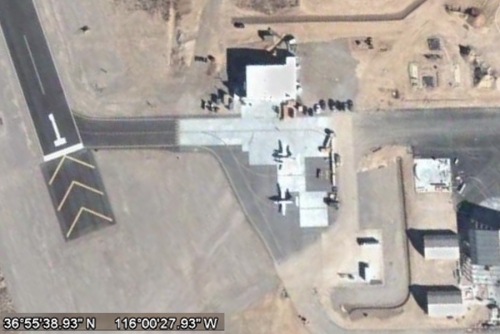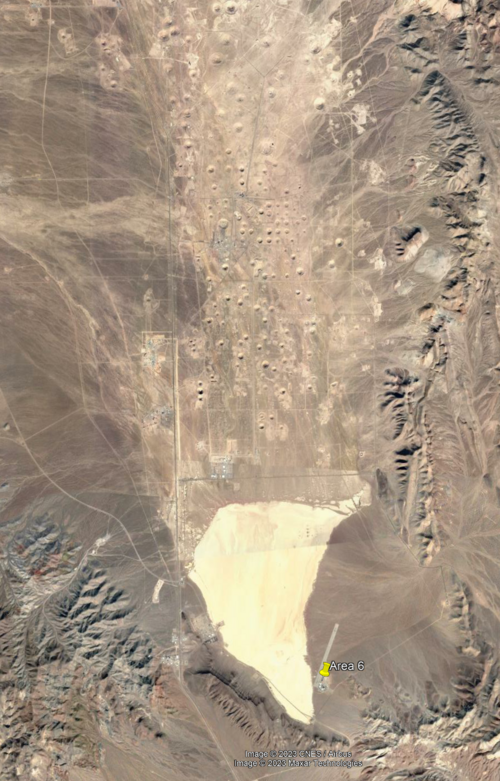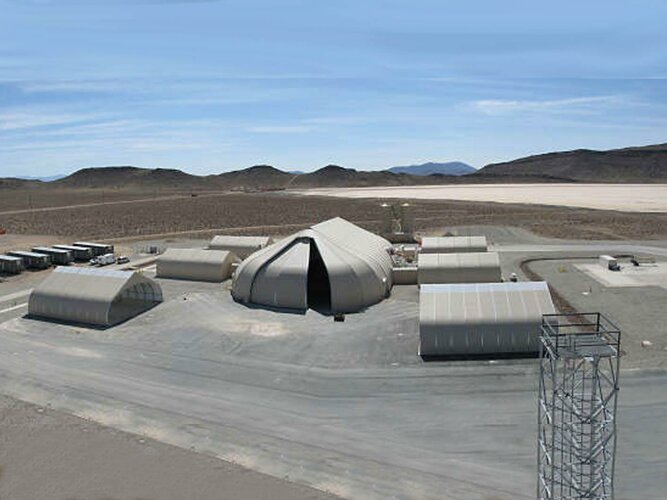antigravite
ACCESS: Top Secret
- Joined
- 25 April 2008
- Messages
- 833
- Reaction score
- 238
Hi.
It's been a long time. The topic of "Area 6" was missing here. FWIW, let me open it up.
- - - - - - - - -
Stephen Francis Tomajczyk, Us Elite Counter-Terrorist Forces , Motorbooks Power, 29/10/1997 - ISBN 0-7603-0220-0
Esp. see Chapter on NEST (Nuclear Emergency Search Team). relevant source herein (this topic)
- - - - - - - - -
1988. Airborne Response Team (ART) Hangar built.
2000. (December) EA (DOE/EA-1334) document written to establish the AOF at the NTS.
2001. The AOF, located in Area 6 at the NTS, east of Yucca Lake is established, incorporating ART Hangar.
2004 (October). AOF EA modifications.
2004. DOE document issued.
http://nnsa.energy.gov/sites/default/files/nnsa/inlinefiles/doe%202004d.pdf
Josh Begley [joshbegley.com], "How do you measure a military footprint?," empire.is, 05/12/2013
http://empire.is/
Lorenzo Franceschi-Bicchierai, "Mapping the Blind Spots: Developer Unearths Secret U.S. Military Bases", Mashable, 13/12/2013,
http://mashable.com/2013/12/13/data-artist-satellite-pictures-military-bases/#pcGA5DbbaqqC
Sferrin [topic starter, alias], "Mystery picture. (Base near Area 51)", secretprojects.co.uk [forum], 15/12/2013
http://www.secretprojects.co.uk/forum/index.php/topic,20979.0.html
Keith Rogers, "You know Area 51, but just what in the world is Area 6?," Las Vegas Review Journal, 05/03/2016,
http://www.reviewjournal.com/news/nevada/you-know-area-51-just-what-the-world-area-6
Clemence Michallon, "Area 6 revealed: Top-secret Nevada facility rumored to be where the Pentagon tests high-tech unmanned drones to detect terrorist dirty bombs is as ultra hush-hush as the more infamous Area 51, DailyMail Online, 07/03/2016,
http://www.dailymail.co.uk/news/article-3479866/Area-6-9-6m-Nevada-airbase-Defense-Homeland-Security-test-aircraft-shows-Google-Earth.html
Tia Ghose (Senior Writer), "Mysterious 'Area 6' Landing Strip in Nevada Desert Baffles Experts," Live Science, 07/03/2016,
http://www.livescience.com/53967-area-6-tests-drone-planes.html
Anon., "Google Earth Reveals Area 6, Top Secret Base," Lifezette.com, 07/03/2016
http://www.lifezette.com/quickzette/google-earth-reveals-area-6-top-secret-base/
{CM note: FB Push via Buffer app.}
Kyle Mizokami, "Area 6: America's Secret Drone Testing Ground? - What goes on in the middle of the Nevada desert isn't exactly clear," Popular Mechanics, 08/03/2016,
http://www.popularmechanics.com/military/research/a19805/area-6-americas-secret-drone-testing-ground/
Anon. "Google Earth reveals layout of secret 'Area 6'," Aol.com, 08/03/2016,
http://www.aol.com/article/2016/03/08/google-earth-reveals-layout-of-secret-area-6/21324410/
"Area 6: America’s Secret Drone Testing Ground?", UAS Vision, 11/03/2016
http://www.uasvision.com/2016/03/11/area-6-americas-secret-drone-testing-ground/
NOTE: sourcing Los Angeles Review Journal
antigravite [topic starter, alias], "Area 6", secretprojects.co.uk [forum], 06/04/2016
http://www.secretprojects.co.uk/forum/index.php/topic,27037
A.
It's been a long time. The topic of "Area 6" was missing here. FWIW, let me open it up.
- - - - - - - - -
Stephen Francis Tomajczyk, Us Elite Counter-Terrorist Forces , Motorbooks Power, 29/10/1997 - ISBN 0-7603-0220-0
Esp. see Chapter on NEST (Nuclear Emergency Search Team). relevant source herein (this topic)
- - - - - - - - -
1988. Airborne Response Team (ART) Hangar built.
2000. (December) EA (DOE/EA-1334) document written to establish the AOF at the NTS.
2001. The AOF, located in Area 6 at the NTS, east of Yucca Lake is established, incorporating ART Hangar.
2004 (October). AOF EA modifications.
2004. DOE document issued.
http://nnsa.energy.gov/sites/default/files/nnsa/inlinefiles/doe%202004d.pdf
Josh Begley [joshbegley.com], "How do you measure a military footprint?," empire.is, 05/12/2013
http://empire.is/
Lorenzo Franceschi-Bicchierai, "Mapping the Blind Spots: Developer Unearths Secret U.S. Military Bases", Mashable, 13/12/2013,
http://mashable.com/2013/12/13/data-artist-satellite-pictures-military-bases/#pcGA5DbbaqqC
Sferrin [topic starter, alias], "Mystery picture. (Base near Area 51)", secretprojects.co.uk [forum], 15/12/2013
http://www.secretprojects.co.uk/forum/index.php/topic,20979.0.html
Keith Rogers, "You know Area 51, but just what in the world is Area 6?," Las Vegas Review Journal, 05/03/2016,
http://www.reviewjournal.com/news/nevada/you-know-area-51-just-what-the-world-area-6
Clemence Michallon, "Area 6 revealed: Top-secret Nevada facility rumored to be where the Pentagon tests high-tech unmanned drones to detect terrorist dirty bombs is as ultra hush-hush as the more infamous Area 51, DailyMail Online, 07/03/2016,
http://www.dailymail.co.uk/news/article-3479866/Area-6-9-6m-Nevada-airbase-Defense-Homeland-Security-test-aircraft-shows-Google-Earth.html
Tia Ghose (Senior Writer), "Mysterious 'Area 6' Landing Strip in Nevada Desert Baffles Experts," Live Science, 07/03/2016,
http://www.livescience.com/53967-area-6-tests-drone-planes.html
Anon., "Google Earth Reveals Area 6, Top Secret Base," Lifezette.com, 07/03/2016
http://www.lifezette.com/quickzette/google-earth-reveals-area-6-top-secret-base/
{CM note: FB Push via Buffer app.}
Kyle Mizokami, "Area 6: America's Secret Drone Testing Ground? - What goes on in the middle of the Nevada desert isn't exactly clear," Popular Mechanics, 08/03/2016,
http://www.popularmechanics.com/military/research/a19805/area-6-americas-secret-drone-testing-ground/
Anon. "Google Earth reveals layout of secret 'Area 6'," Aol.com, 08/03/2016,
http://www.aol.com/article/2016/03/08/google-earth-reveals-layout-of-secret-area-6/21324410/
"Area 6: America’s Secret Drone Testing Ground?", UAS Vision, 11/03/2016
http://www.uasvision.com/2016/03/11/area-6-americas-secret-drone-testing-ground/
NOTE: sourcing Los Angeles Review Journal
antigravite [topic starter, alias], "Area 6", secretprojects.co.uk [forum], 06/04/2016
http://www.secretprojects.co.uk/forum/index.php/topic,27037
A.























